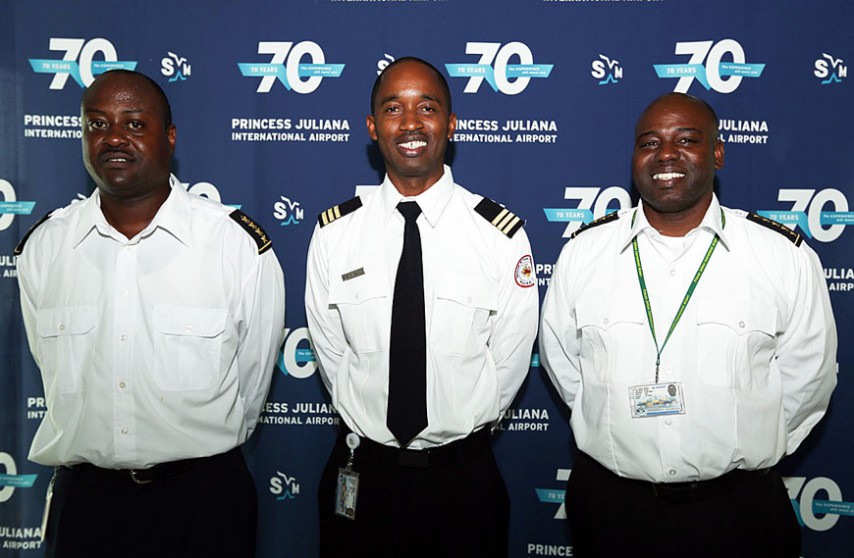Sint Maarten. Firefighter: It’s not something you do; it’s something you are

SIMPSON BAY, St. Maarten (Friday, July 25, 2014)—As the curtain came down Friday on Firemen’s Week 2014, it became necessary to look back at the 19 years of Rescue and Fire-Fighting (R&FF) at the Princess Juliana International Airport, SXM.

SXM firefighters (L-R), Damian Cooks, Mauricio A. Webster, Manilo Penijn, “safety is everyone’s business.” (SXM photo)
“We haven’t had any major incident,” recalls Manilo Penijn, manager of the R&FF Department.
Knock on wood. Penijn has served in the department from its very inception and only remembers “small cases with no fatalities.”
Shortly after it was established though, the Department had to assist the St. Maarten fire station during Hurricane Luis in 1995. Talk of a baptism of fire, literally. Since then, SXM firemen have had to respond to the Prime Distributors fire and a DC-3 aircraft, which used to bring bread from Puerto Rico, among several others. The latter, according to another 19-year veteran of the department, Mauricio A. Webster, came in once with its “wheels on fire.”
“Minor” as these incidents may seem – (most cases that the R&FF Department at SXM have had to deal with have been medical emergencies, averaging about 15 per month, according to Penijn) – the fact still remains that the firemen are not just folding their arms every day, waiting for something to happen.
“People think we’re in the business of waiting for a fire, but it’s quite the opposite: we try to prevent fires and rescue lives,” said Webster, who added that the Firemen’s Week served to “raise awareness and show a little bit of what we do.”
Deputy manager of the department, Damian Cooks, a former US Military officer with extensive experience in aircraft firefighting, said he would rate the practical and operational preparedness of his men at 95%.
“We are ready for anything,” he said. “We have only about another 5% we have to work on.”
Firefighting is obviously not for the faint-hearted. In fact, as a popular pinup legend states: “Firefighter: It’s not something you do; it’s something you are.” Physical and mental fitness are basic requirements, while firemen must be willing to adapt to a rapidly changing world, both in terms of the physical structures, technology and the expectations of the communities they serve.
Training
“Firefighting can be taxing on your body,” noted Webster. “The training in itself is very hard because we always train for the worst-case scenarios.”
Comparing the training he received at the beginning of his career to now, Webster said, “back then, we were really trained and prepared only for aircraft firefighting. But there have been changes in structure and in aircrafts as well. Right now, though, we’re being trained for both aircraft firefighting and what you would call ‘normal’ firefighting.”
Penijn put it this way: “I’ve been here from the very start and I know where we were then and where we are today. The training at the time was more like a crash course. Today, the foundation of the department is very, very strong, where it concerns training. The initial course was a Dutch system. The new guys come back from the US with more information and education. The change to the National Fire Protection Association (NFPA) has meant that everybody in the department has the same basic foundation. I would say now, we’re better prepared than before.”
For Cooks, “in firefighting, you never get rusty because every aspect of the training is used on the job.”
Female Firefighters
According to Webster, one of the major changes in the department concerns the age of the personnel.
“A lot of younger people are coming in and the older guys are leaving and moving on. We have a new, young breed now. It’s always good to know that we can attract young people who want to join the service,” he said.
The department now has a staff of 28.
“We’re trying to get to 32,” revealed Penijn, or an average of 10 persons per shift. He said the youngest fireman is 19, while the oldest is about 54, but “the majority are in their 30s.”
“The younger, the more the body can take. Ideally, we want them between 18 and 21,” Penijn said.
All the firefighters at SXM’s R&FF Department are men. Cooks considers this an anomaly in today’s world in which he said women are climbing all kinds of ladders – the corporate ladder, and the firefighting ladder as well. Cooks who has done both military and volunteer firefighting when he was in the United States said in his experience, women make very fine firefighters as well.
“I’m very surprised at the fact that we don’t have female firefighters yet in the department,” he said, adding: “one of my goals is to get at least two or three. They will give the men more competition and keep them on their toes. You know, there is nothing like women to make men more competitive.” His laughter was contagious.
Indeed, the management of the department is focused on recruiting female firefighters. The process of filling the four available vacancies will start shortly, according to Penijn, who said women have also applied for these positions. “We’re going to look over the applications and call those who make the cut for interviews soon,” he said.
New Facility
The brand new facility to house the department that will be constructed soon will have provisions for female firefighters that were lacking in the previous fire station, Penijn said.
Cooks, his deputy, sees the new facility and the consistent training of the personnel as a moral booster.
“Based on the drawings I have seen for the new fire station, the airport management is doing a wonderful job in upgrading our facility. This, and the training of the staff, has lifted the moral of the guys a lot,” he said. “Our equipment is state of the art, and though we have a lot of work in terms of physical training, we’re getting there.”
“Management has been good to us with regards to what we need to perform our duties and our safety,” Webster said. “We’ve just got new suits. A new building is coming. They make sure we get what we need to get the job done.”
He was quick to point out, however, that “firefighting is a very expensive business.” To outfit a firefighter, from the helmet to the shoes, would cost a minimum of about US$6,000 and up. This, of course, does not include other costs like the fire engines and other equipment and training.
“Since we’ve turned to the American ranking, training will take another two years to complete,” said Penijn. “It is not cheap. We have to do aircraft firefighting training on a yearly basis in accordance with ICAO requirements. If we get our local firefighting instructors certified, we will save costs because we won’t have to send staff overseas for training all the time.”
Recognition
While the trio of Penijn, Cooks and Webster agree that the working conditions and training of the firefighters have improved a lot, Webster noted that “as far as recognition is concerned, the community can do more.”
“If you go to some of the restaurants,” he said, “they’ll give you half price if they know you’re a fireman, but we don’t get that in many other places. In other parts of the world, they really honor their firemen. I know the community supports us in other ways, but the respect and consideration of the job we do can still be better.”
Looking forward, however, Penijn, sees an even brighter future for the department.
“I’d like to see the department in the next five years be recognized as a full-fledged fire department,” he said, “supporting the local economy and government.”
“I’d like to see that we become self-sustained when it comes to major incidents. Right now, if there’s a major incident, the local fire department takes over command because they are in charge of disaster management. We (R&FF) are an initial response team. I’d really like to see that in the next five years that we can handle all emergencies by ourselves.”
This will require, according to Penijn, “more manpower, more resources, and that we enter an agreement with the local fire department.”
This is not to say there’s anything wrong with the working relationship with the local fire department. To the contrary, “the level of cooperation with them is really good,” said Cooks. “And we intend to keep it that way and improve on it.”
After all, as Webster put it: “safety is everyone’s business.”
By Fabian A. Badejo for SXM Airport




